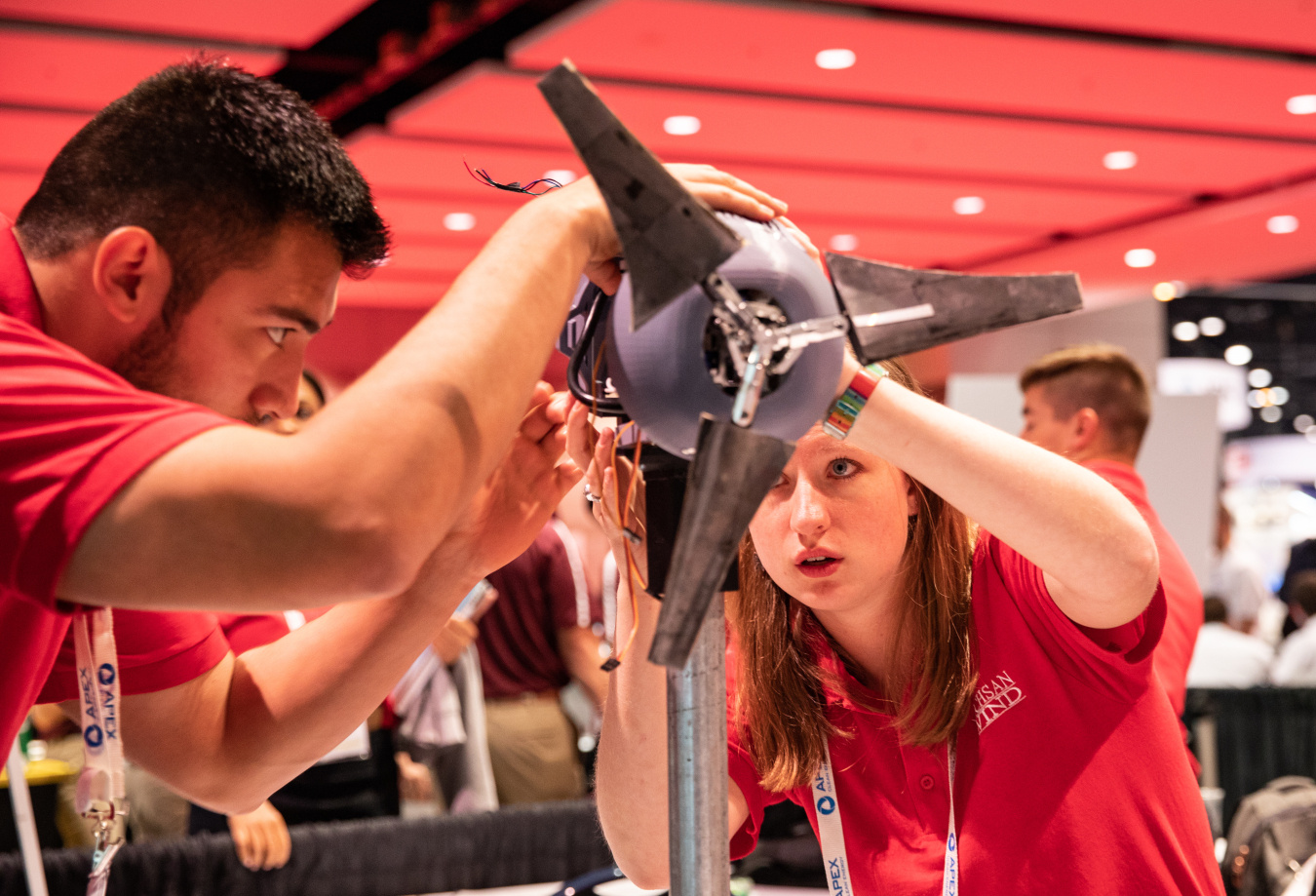Find out where to start, what to expect, and how to stand out now that EERE has issued the Collegiate Wind Competition 2021 call for proposals.
September 27, 2019The United States has a growing need for skilled entry-level wind energy professionals. A recent report from the U.S. Department of Energy's (DOE’s) National Renewable Energy Laboratory (NREL) found that closing the wind workforce gap between hiring companies and qualified applicants for open entry-level positions could reduce recruiting costs, better satisfy employer needs, and grow the domestic wind workforce.

Two students from the University of Wisconsin—Madison adjust their model wind turbine during the Collegiate Wind Competition 2018. A member of this student team went on to receive a job offer even before graduating. Photo by Werner Slocum, NREL
But which comes first—the job or the experience? DOE’s Collegiate Wind Competition (CWC) offers students a unique opportunity to gain hands-on experience designing, building, and testing a model wind turbine while still in college. Each team also goes through the process of planning and financially analyzing a wind plant to gain experience solving real-world challenges. With industry experts and networking opportunities available for professional development during the competition, it’s no surprise that past participants have received job offers even before graduating.
Where To Start
Now that DOE has issued the CWC 2021 request for proposals, students and faculty members can begin making plans to participate. This is the time to gather support by networking with your school’s administration. Full submissions, which need to include a cover letter, technical proposal, and supporting materials, can be submitted any time before Monday, December 9, 2019, for consideration.
If that first step feels big, know that technical proposals are limited to 10 pages. Using the approved format, interested schools can outline plans for developing a turbine concept. Students and faculty sponsors are asked to present their ideas for academic integration, project planning, institutional support and fundraising, and communication and outreach in the proposal. This structure ensures that teams have carefully considered all aspects required to be successful in the competition.
The supporting materials requirement includes a few legal forms that allows competition organizers to enter into an agreement with the university. Submit these along with your cover letter and proposal, and you’ve already gained experience putting together a competitive request for proposals (RFP) response. Applicants are encouraged to contact competition organizers for guidance as needed.
What To Expect
NREL will perform an initial evaluation to ensure that your proposal is clear and complete. You will be notified if any clarification is needed or if your offer is unacceptable for a specific reason. After weighing applications based on the qualitative merit criteria listed in the RFP, in spring 2020 the organizers will announce the selection of up to 12 collegiate teams to compete.
The competing teams will have a full year to design and build a model wind turbine that can stand up to the challenge of a massive wind tunnel and plan, financially analyze, and present research on a wind plant. In spring 2021, the competition will be held at either the American Wind Energy Association’s CLEANPOWER Conference in Indianapolis, Indiana, or at NREL’s Flatirons Campus in Boulder, Colorado.
How To Stand Out
Schools are selected to participate in the competition based on the merits of their proposal. First and foremost, verify that your school is able to merge the CWC contest areas with the academic experience available on campus or within your community. If your school is committed to multiyear wind education, NREL staff can also help selected schools develop wind energy engineering, business, and siting programs and coursework.
It’s important to demonstrate a complete understanding of the CWC as part of your application. Past participants have found it helpful to take the following steps:
- Review competition Rules and Requirements and previous written reports.
- Start assembling a team of faculty advisors and interested students.
- Begin garnering support through potential sponsors and mentors.
- Conduct mock competitions at your institution based on CWC contests.
Finally, share what makes your team strong. How is your team taking the lessons learned beyond the classroom? What plans do you have to overcome the challenges of the competition and obstacles that are unique to your team? We’ve seen students from Puerto Rico’s Team Juracán channel resiliency following Hurricane Maria, and applauded as team members from the University of Wisconsin—Madison and James Madison University gave back to their communities by volunteering at the KidWind event for students in grades 4-12.
The highly publicized competition seeks to promote schools’ strengths and develop the next generation of wind energy industry professionals. By joining forces with DOE and NREL, students will gain invaluable experience that is useful not just for getting your dream job, but also for performing well in that role.
Hear directly from the organizers and get your RFP questions answered at the upcoming informational webinar, scheduled for Thursday, Oct. 17, at 4 p.m. EST.

